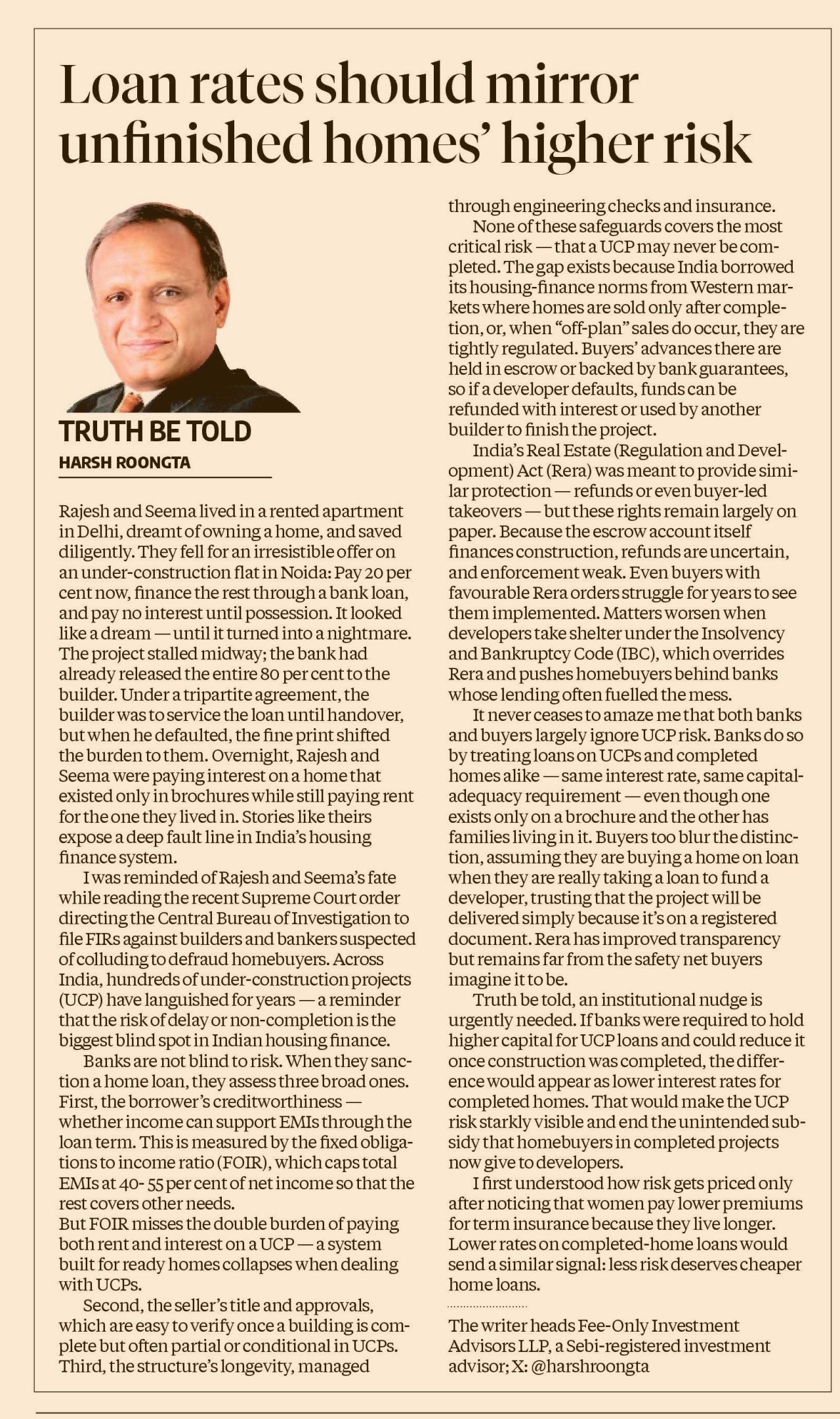
Rajesh and Seema lived in a rented apartment in Delhi, dreamt of owning a home, and saved diligently. They fell for an irresistible offer for an under-construction flat in Noida: pay 20 per cent now, finance the rest through a bank loan, and pay no interest until possession. It looked like a dream — until it turned into a nightmare. The project stalled midway; the bank had already released the entire 80 per cent to the builder. Under a tripartite agreement, the builder was to service the loan until hand-over, but when he defaulted, the fine print shifted the burden to them. Overnight, Rajesh and Seema were paying interest on a home that existed only in brochures while still paying rent for the one they lived in. Stories like theirs expose a deep fault line in India’s housing finance system.
I was reminded of Rajesh and Seema’s fate while reading the recent Supreme Court order directing the CBI to file FIRs against builders and bankers suspected of colluding to defraud homebuyers. Across India, hundreds of under-construction projects (UCP) have languished for years — a reminder that the risk of delay or non-completion is the biggest blind spot in Indian housing finance.
Banks are not blind to risk. When they sanction a home loan, they assess three broad ones. First, the borrower’s creditworthiness — whether income can support EMIs through the loan term. This is measured by the Fixed Obligations to Income Ratio (FOIR), which caps total EMIs at about 40–55% of net income so that the rest covers other needs. But FOIR misses the double burden of paying both rent and interest on an UCP — a system built for ready homes collapses when dealing with UCPs.
Second, the seller’s title and approvals, which are easy to verify once a building is complete but often partial or conditional in UCPs. Third, the structure’s longevity, managed through engineering checks and insurance.
None of these safeguards covers the most critical risk — that an UCP may never be completed. The gap exists because India borrowed its housing-finance norms from Western markets where homes are sold only after completion, or, when “off-plan” sales do occur, they are tightly regulated. Buyers’ advances there are held in escrow or backed by bank guarantees, so if a developer defaults, funds can be refunded with interest or used by another builder to finish the project.
India’s Real Estate (Regulation and Development) Act (RERA) was meant to provide similar protection — refunds or even buyer-led takeovers — but these rights remain largely on paper. Because the escrow account itself finances construction, refunds are uncertain, and enforcement weak. Even buyers with favourable RERA orders struggle for years to see them implemented. Matters worsen when developers take shelter under the Insolvency and Bankruptcy Code (IBC), which overrides RERA and pushes homebuyers behind banks whose lending often fuelled the mess.
It never ceases to amaze me that both banks and buyers largely ignore UCP risk. Banks do so by treating loans on UCPs and completed homes alike — same interest rate, same capital-adequacy requirement — even though one exists only on a brochure and the other has families living in it. Buyers too blur the distinction, assuming they are buying a home on loan when they are really taking a loan to fund a developer, trusting that the project will be delivered simply because it’s on a registered document. RERA has improved transparency but remains far from the safety net buyers imagine it to be.
Truth be told, an institutional nudge is urgently needed. If banks were required to hold higher capital for UCP loans and could reduce it once construction was completed, the difference would appear as lower interest rates for completed homes. That would make the UCP risk starkly visible and end the unintended subsidy that homebuyers in completed projects now give to developers.
I first understood how risk gets priced only after noticing that women pay lower premiums for term insurance because they live longer. Lower rates on completed-home loans would send a similar signal: less risk deserves cheaper home loans.
Blurb : Banks and buyers ignore the higher risk in under-construction properties; it’s time home loan rates made that difference visible.
The writer heads Fee-Only Investment Advisors LLP, a Sebi-registered investment advisor; X (formerly Twitter): @harshroongta
Disclaimer: These are personal views of the writer. They do not necessarily reflect the opinion of www.business-standard.com or the Business Standard newspaper
(A slightly different version of this column first appeared in the Business Standard on October 06, 2025)
